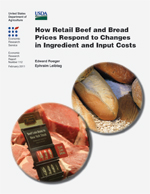How Retail Beef and Bread Prices Respond to Changes in Ingredient and Input Costs
- by Edward Roeger and Ephraim Leibtag
- 2/24/2011
Overview
The extent to which cost changes pass through a vertically organized production process depends on the value added by each producer in the chain as well as a number of other organizational and marketing factors at each stage of production. Using 36 years of monthly Bureau of Labor Statistics price indices data (1972-2008), we model pass-through behavior for beef and bread, two retail food items with different levels of processing. Both the farm-to-wholesale and wholesale-to-retail price responses are modeled to allow for the presence of structural breaks in the underlying long-term relationships between price series. Broad differences in price behavior are found not only between food categories (retail beef prices respond more to farm-price changes than do retail bread prices) but also across stages in the supply chain. While farm-to-wholesale relationships generally appear to be symmetric, retail prices have a more complicated response behavior. For both bread and beef, the passthrough from wholesale to retail is weaker than that from farm to wholesale.
Download
-
Entire report
Download PDF -
Report summary
Download PDF -
Download ERR112.zip
Download ZIP

